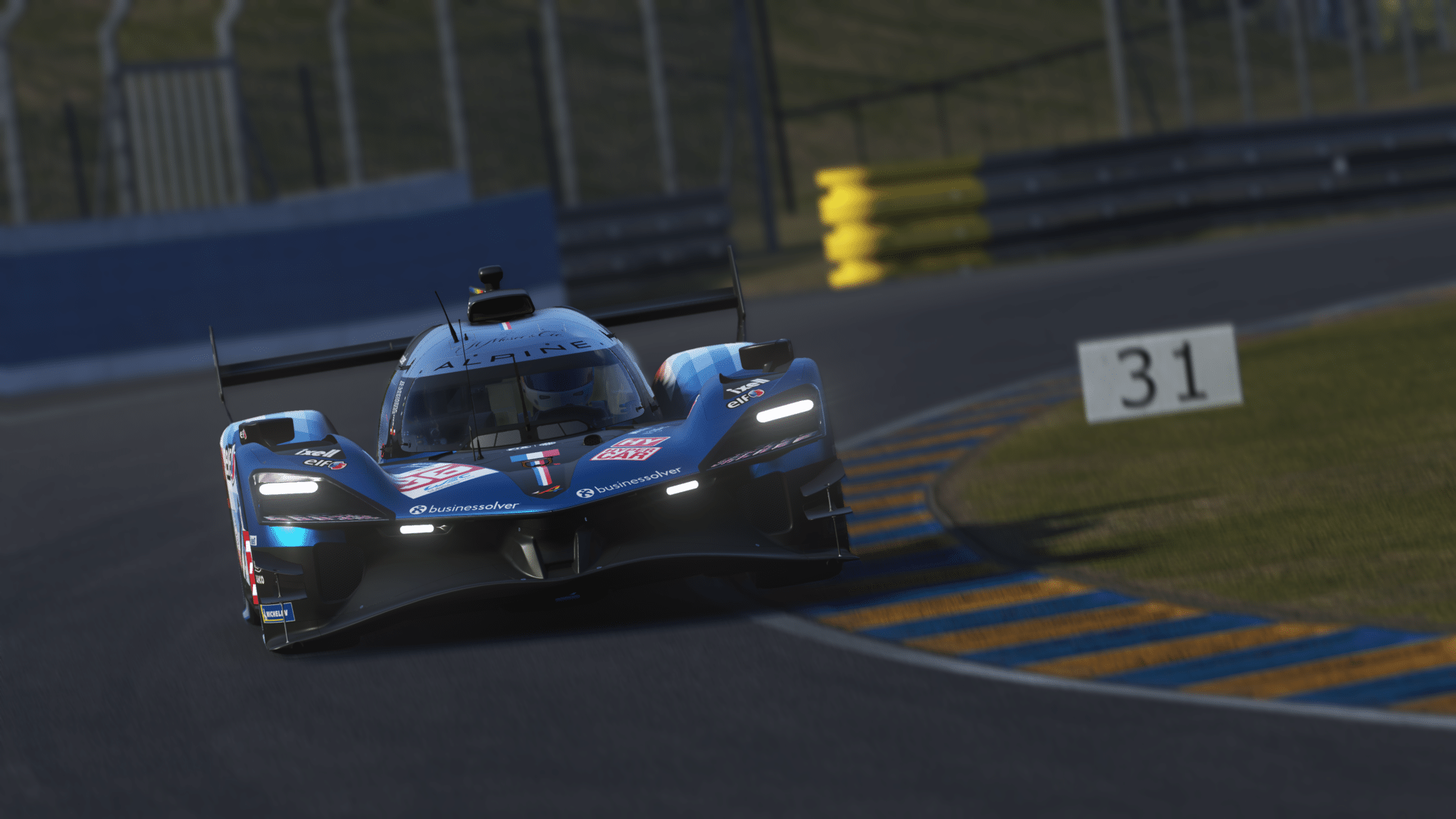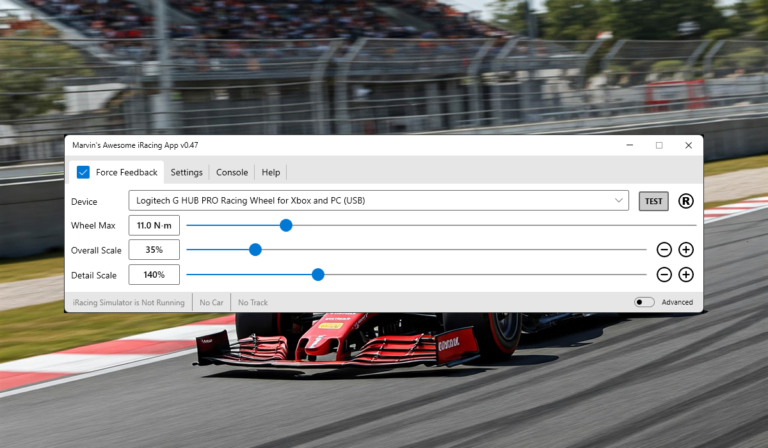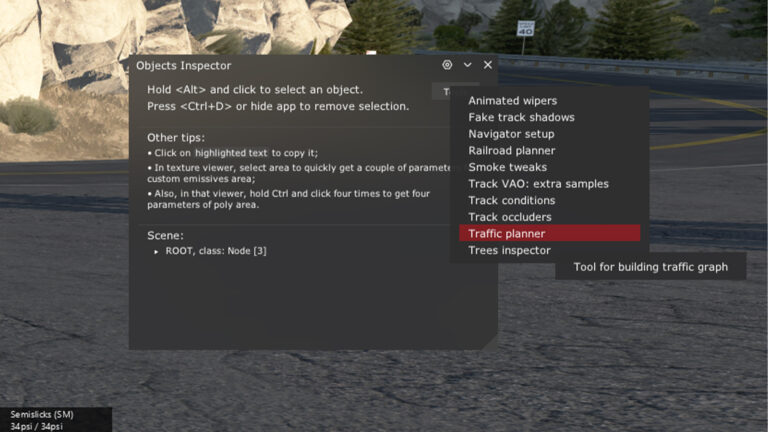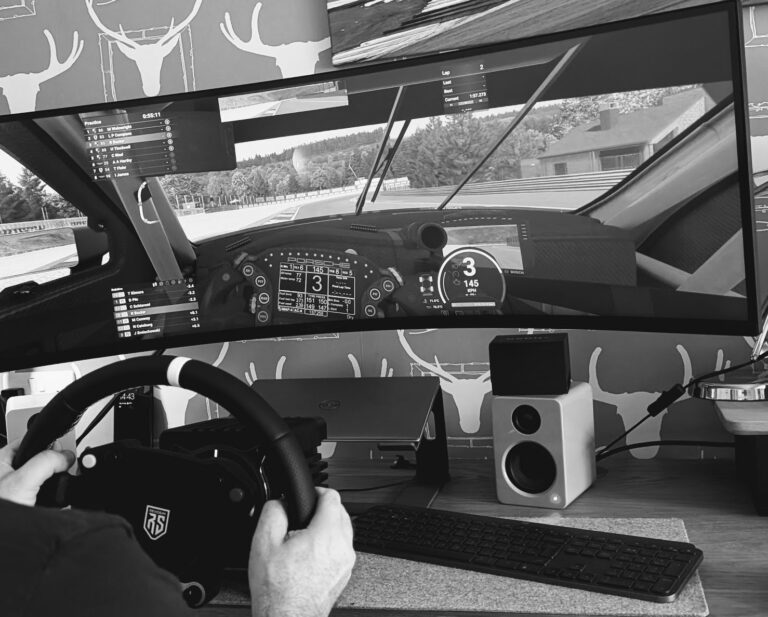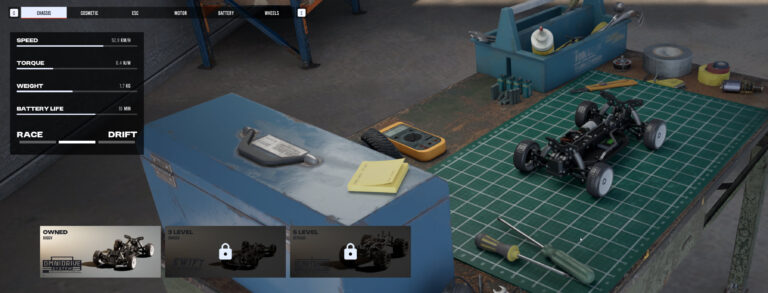After eighteen months in early access and against considerable odds, Le Mans Ultimate has officially reached version 1.0. The sim racing community’s scepticism was understandable – Motorsport Games’ troubled history with NASCAR 21: Ignition and failed promises across multiple racing licenses had left many doubting whether this official FIA World Endurance Championship title would ever see the light of day.
Yet here we are, with what many consider the finest hypercar racing simulator available. Whether it truly deserves that “1.0” designation remains contentious.
From Disaster to Redemption
The transformation of Motorsport Games under CEO Stephen Hood’s leadership has been nothing short of remarkable. From producing what was widely regarded as one of the worst racing games in recent memory to crafting a simulation that’s now stealing thunder from established titles like Assetto Corsa Competizione represents one of gaming’s more unlikely redemption stories. When I first got this game back in early access, it was a bit of a shell – light on content, riddled with glitches, and performance wasn’t quite there. However, over the course of various early access releases, the game has certainly improved, culminating in its current state.

The journey through early access hasn’t been without controversy – though it’s worth noting that all content updates during this period were free, with paid DLC only arriving after the v1.0 launch. The end result speaks volumes about the studio’s renewed focus on quality. And yes, whilst the game is absolutely best enjoyed on a wheel, it’s perfectly playable on a controller – my eight-year-old plays everything with a gamepad, though the depth of the simulation really shines through with proper hardware.
Version 1.0 arrives with modest content additions: the naturally aspirated Aston Martin Valkyrie AMR LMH hypercar and Mercedes-AMG LMGT3, plus a refreshed BMW M4 LMGT3 Evo for existing DLC owners. The 2025 FIA WEC season liveries are included (with LMP2 schemes to follow), alongside those LED position displays that have become synonymous with modern endurance racing. It’s not a content bonanza, but what’s here is meticulously crafted.

What’s Missing From 1.0
Let’s address the most glaring omission first: there’s no career mode. No championship progression. No team management. In fact, you can’t even race through a complete World Endurance Championship season in the official game of that very series. For a title bearing the “1.0” label, this feels less like a full release and more like an exceptionally polished online racing platform that happens to include some offline functionality.
I’m probably one of the few people who doesn’t fully agree that this should be called 1.0 – hear me out on this. We gave them a pass on missing features during early access, but now that it’s supposedly “complete”, we need to call out what’s still absent: proper head tracking setup, comprehensive telemetry output, driver swaps (coming later), and that single-player career mode.
The comparison to KartKraft – another Motorsport Games acquisition that they effectively saved before reaching “1.0” without fundamental features – looms large. I remember getting that game when it first appeared in early access, and like many others, I was left with a nasty taste when promised features never materialised.
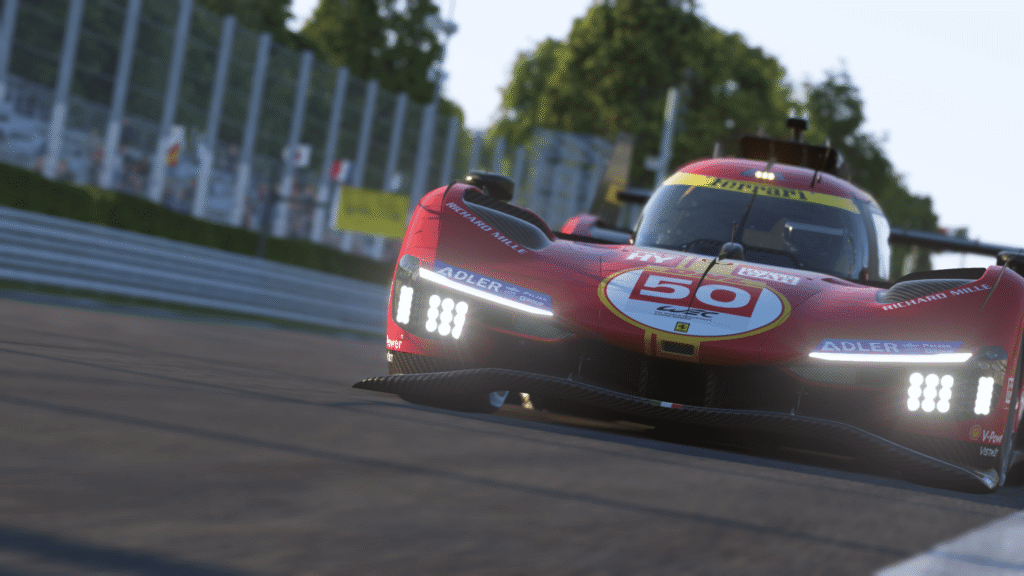
While MSG’s improved financial position (bolstered by investment from VR specialists Pimax) and Hood’s track record suggest a different outcome this time, the spectre of broken promises haunts the sim racing community’s collective memory. The promised single-player championship mode is currently targeted for Q3 2024, with a more comprehensive career mode remaining a longer-term aspiration without a confirmed timeline.
The Driving Experience
If Le Mans Ultimate’s feature set disappoints, its driving experience emphatically does not. This is simulation at its finest, building on rFactor 2‘s legendary physics foundation to create something that feels properly special – you can definitely feel that DNA, which is a very good thing. From the moment you exit the pit lane on cold tyres and brakes, the game demands respect.
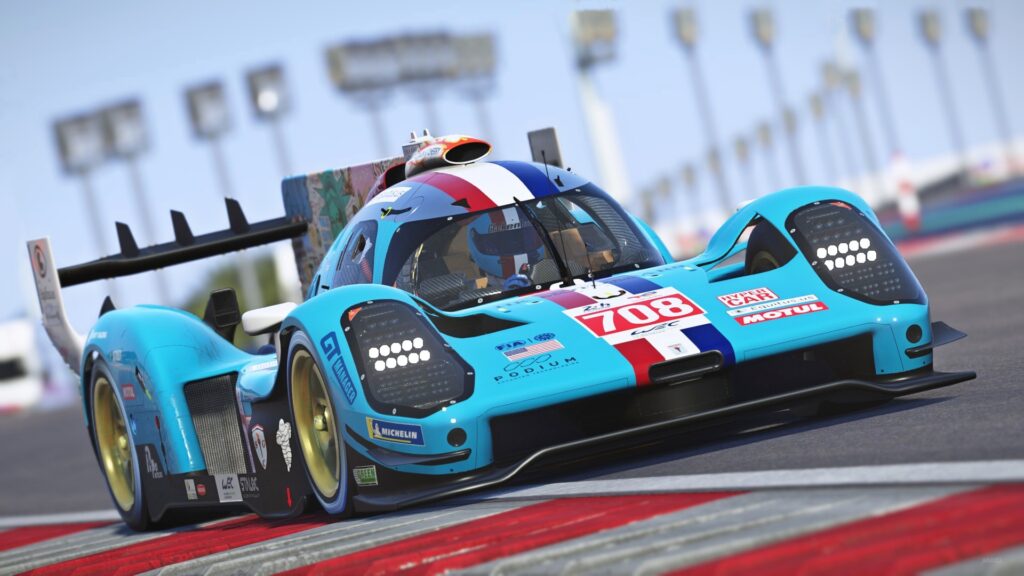
I’ve found that first outlap can be a proper baptism of fire – struggling through with cold brakes and tyres, it’s easy to get caught out if you push too early. But with patience, bringing everything up to temperature and finding that rhythm, it all clicks together beautifully.
Using my Simucube wheelbase, the force feedback delivers an almost overwhelming stream of information – what I can only describe as an uncompromised buffet of data. Every texture in the laser-scanned tarmac courses through your hands in high fidelity. Lock a wheel under braking and you’ll not only see the telltale puff of smoke but feel the subsequent flat spot creating a cacophony of vibrations and judders lap after lap. Yet somehow all this telemetry feels more like a symphony than noise – every element working in perfect harmony to put you firmly in the driver’s seat.
The tyre model deserves particular praise. Temperature management isn’t just a number on a HUD display; you genuinely feel the transition from cold to optimal temperature through progressive changes in grip and feedback. Even small slide corrections change the feel completely. It’s this attention to detail that elevates Le Mans Ultimate beyond mere simulation into something approaching art.
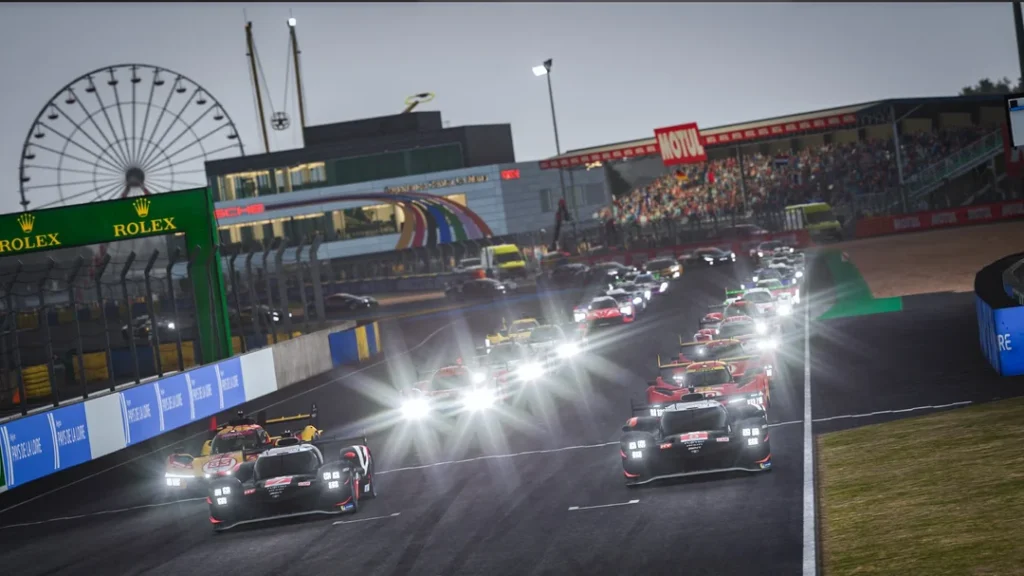
Each of the four available classes – Hypercar, LMDh, LMP2, and LMGT3 – possesses distinct characteristics that go well beyond simple performance differentials. I primarily drive the hypercars, and I’ve always loved how dynamic they feel – they really give you the sense that the driver can make a massive difference. The hybrid systems add genuine strategic depth, whilst the LMGT3 machines reward smooth, precise inputs in a way that perfectly captures the essence of GT racing.
Want an extreme example of how different each car feels? Jump from the Glickenhaus straight into the Ferrari, or drive the freshly released AMG GT3 before switching to the Porsche. Everything drives exactly as it should. Even within classes, each manufacturer’s interpretation shines through. The raw, naturally aspirated fury of the new Valkyrie contrasts beautifully with the sophisticated hybrid complexity of rivals like the Ferrari 499P or Porsche 963. It’s probably one of my favourite driving experiences in sim racing at the moment.
Graphics and Performance Issues
Graphically, Le Mans Ultimate presents a mixed picture. In optimal conditions – particularly during those magical golden hour transitions at dusk and dawn – the game can be genuinely stunning. Weather effects impress, with rain creating convincing spray patterns and standing water that affects handling in realistic ways. The car models are exemplary, capturing even minor details like the way brake discs glow under heavy use or how bodywork flexes over kerbs.
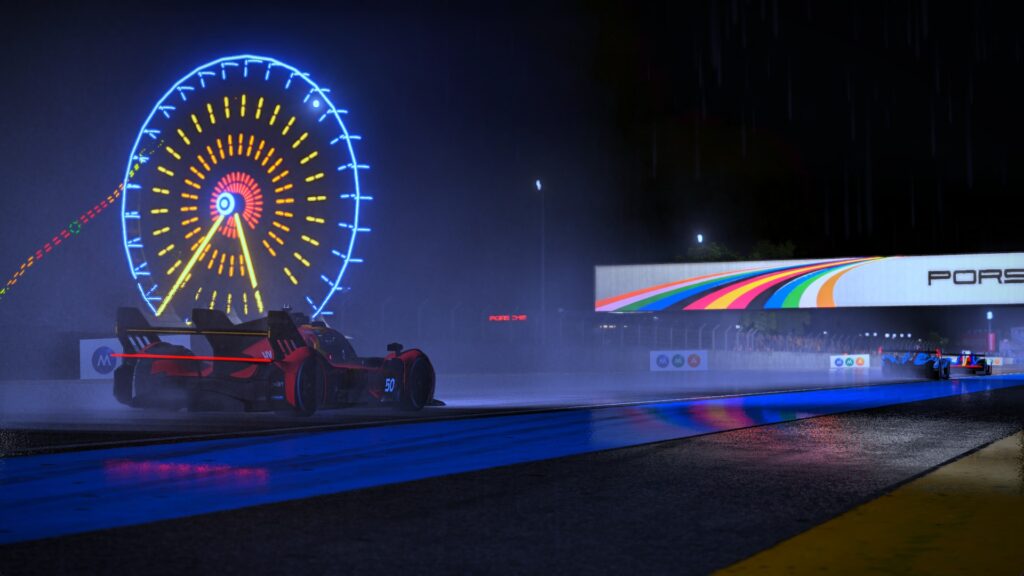
However, technical issues persist. Shadow flickering around catch fencing proves particularly distracting, while replay mode performance with full grids at Circuit de la Sarthe can bring even powerful systems to their knees. Loading times feel punitive compared to contemporary titles, and oddities like wet weather conditions not translating correctly to replays suggest optimisation work remains incomplete.
More concerning are the performance issues encountered during testing. Full AI grids at certain circuits proved problematic even on my RTX 4090-equipped system, with Le Mans itself requiring reduced car counts to maintain playable framerates. During my testing with full multiclass grids at Circuit de la Sarthe and Spa, I experienced a bizarre GPU-related issue where AI opponents would… well, let’s just say they started behaving very strangely.
At Spa, I managed to fix it with some recommended settings tweaks, but I simply couldn’t get a full grid race at Le Mans working without dropping the AI car count – and this is on hardware that should handle anything thrown at it.

Forums throughout early access suggest I’m far from alone with these problems, and performance seems wildly inconsistent between systems – one reviewer mentioned their colleague found the same setup completely unplayable whilst theirs ran acceptably.
I certainly don’t experience anything similar in other sims on this hardware. Such inconsistency raises serious questions about the game’s readiness for primetime. The prospect of console ports “at least a year away” seems optimistic given these PC performance concerns.
Setting Up Your Rig
While the game has its issues, there are ways to optimise your experience. After extensive testing, here are the settings that have worked best for me across different hardware configurations.
Triple Screen Monitor Setup
Setting up triples in Le Mans Ultimate can be frustrating – the multi-view option might be greyed out initially. The solution? Access the multi-view tool by pressing Ctrl+Shift+= (or Ctrl+Shift+` on some keyboard layouts). If that doesn’t work, you’ll need to edit the Config_DX11.ini file in your UserData folder manually.
For a typical triple 27-inch monitor setup at 60cm distance with 45-degree angles, I use these values:
- ViewParams=(0.610, 0.340, 0.600, 45.000, 0.020)
- LeftView=(0.610, 0.340, 0.600, 45.000, 0.020)
- RightView=(0.610, 0.340, 0.600, 45.000, 0.020)
The format is: screen width (m), screen height (m), eye distance (m), side angle (deg), bezel gap (m). Measure your setup carefully – the width should include the bezel for accurate rendering.
Pro tip: If you’ve got rFactor 2 set up already, you can simply copy your config_dx11.ini file over and your triple screen settings will carry across perfectly.
Force Feedback Configuration
Getting the force feedback right is crucial for extracting Le Mans Ultimate’s exceptional physics. Here’s what I’ve found works best:
For Direct Drive wheels (Simucube, Fanatec DD, etc.):
- Set your Steering Torque Capability to match your wheelbase’s actual Nm rating
- Force Feedback Strength: 100% (reduce to 90% if you experience clipping on sub-10Nm bases)
- Force Feedback Smoothing: 0-3 (I prefer 0 for maximum detail, but some wheels handle the noise better with slight smoothing)
- Minimum Steering Torque: 0% (ignore the warning – it’s for older wheels)
- Curb Vibration/Pull Strength: 0% (prevents violent kerb strikes)
Critical setting: Many wheelbases require “Invert Force Feedback” to be enabled. If your wheel pulls violently left or right, or feels completely wrong, toggle this setting first.
Brand-specific tips:
- Fanatec users: Enable ‘Linear’ instead of ‘Peak’ torque in your control panel
- Thrustmaster: Always invert force feedback
- Logitech G29/G923: Enable “Use constant steering force effect”
Graphics Settings
For those struggling with performance, these settings have helped me maintain 90+ FPS with a full grid:
Essential tweaks:
- Visible Vehicles: 10-15 (this single setting has the biggest impact)
- Shadows: Medium (High causes those flickering issues)
- Reflections: Low or Medium
- DLSS: Quality mode if available (massive performance boost with minimal quality loss)
- VR users: Disable FSAA entirely and use VRSS if your headset supports it
The game’s loading times remain painful regardless of settings – I’ve taken to alt-tabbing and checking emails while waiting for races to load. It’s not ideal, but it’s the reality of the current build.
Online vs Offline Racing
Where Le Mans Ultimate truly excels is in its online implementation. The RaceControl ranking system, inherited and refined from rFactor 2, creates genuinely competitive racing by matching drivers of similar skill levels. Daily and weekly races provide structured competition, while special events capture the essence of endurance racing’s biggest moments. The netcode proves robust, with minimal lag or synchronisation issues even in packed multiclass fields.
The subscription model – RaceControl Pro and Pro+ – remains divisive. While the basic online experience requires no additional payment, the premium tiers unlock curated races, championships, and quality-of-life features like custom liveries. At $84 annually for Pro+, which includes all DLC content, it represents reasonable value for dedicated players but may prove a barrier for casual participants.
Offline, the game offers competent if uninspiring options. Once you finally get into your race – because honestly, the loading times can be painful with a stacked grid – the AI opponents display reasonable racecraft. I’ve noticed some startling slides and the occasional moment where the real driver mask slips, but they make human-like mistakes, and you can have genuinely enjoyable battles. The traffic ballet that WEC is known for works reasonably well, though perhaps a little too much in favour of the player when plotting a path through slower cars. The lack of any progression system means offline racing exists purely for practice or personal satisfaction – fine for hotlapping enthusiasts but desperately lacking for those seeking structured single-player content.
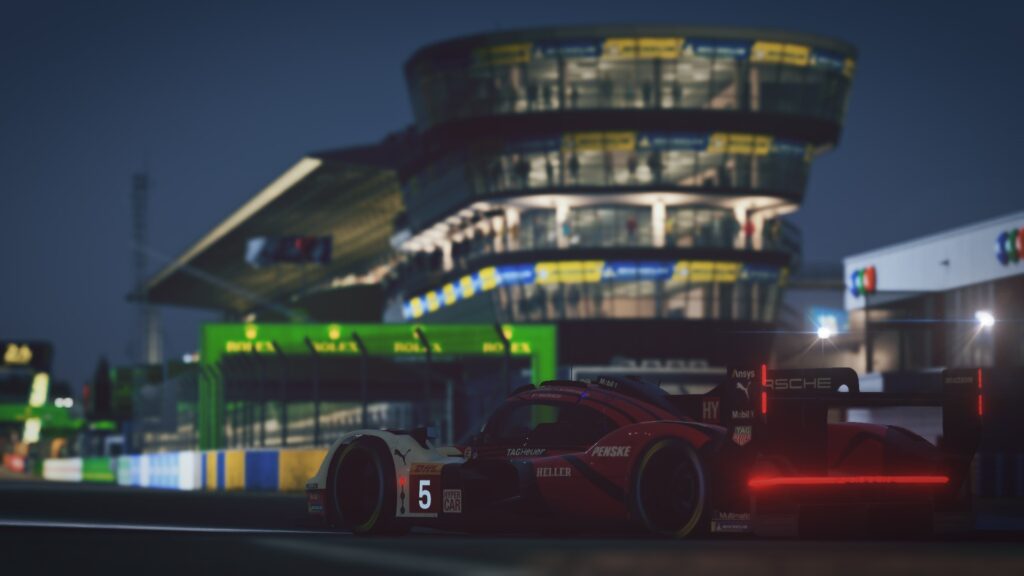
New Cars and 2025 Content
Version 1.0’s additions feel incremental rather than transformative. The Mercedes-AMG LMGT3 handles predictably well, offering the stable, front-engined platform that GT3 racing demands. Its naturally aspirated V8 provides one of the game’s best audio experiences – I found myself mesmerised by the car’s external audio, particularly during a VR race at Le Mans in replay mode.
The Aston Martin Valkyrie stands out more significantly – the only non-hybrid Hypercar on the grid, it offers a purer, more accessible entry point to the top class while sacrificing ultimate performance. After driving it extensively, I can confirm the developers absolutely nailed that piercing tenor tone you hear trackside, though it doesn’t sing quite as sweetly from the cockpit – which actually tallies with real-world driver feedback.
The 2025 season content amounts to livery updates and those LED position displays – nice touches for authenticity but hardly game-changing. Similarly, the UI improvements, while welcome, feel like polish on a system that needed more fundamental restructuring. LMGT3 tyre model updates improve an already excellent system marginally, though most players would struggle to identify the changes without patch notes.
Final Thoughts
Le Mans Ultimate v1.0 presents a fascinating contradiction. As a driving simulator, it stands among the genre’s absolute best, offering a physics model and force feedback implementation that rivals or exceeds anything else available. The online racing structure works brilliantly for those seeking competitive multiclass endurance racing. For this specific audience, it’s an easy recommendation despite its flaws.
Yet calling this a “1.0” release feels disingenuous when fundamental features remain absent. The lack of single-player progression removes a huge swathe of potential enjoyment, while performance inconsistencies and technical rough edges suggest more time in the oven wouldn’t have gone amiss. The shadow of KartKraft’s broken promises looms large, though the current roadmap targeting Q3 2024 for offline championship mode offers more concrete hope than vague future promises.
Perhaps the most telling indicator comes from player numbers. While Le Mans Ultimate’s concurrent players have grown impressively – breaking records with 8,463 players post-launch – context matters. Assetto Corsa, a decade-old title, peaked at 14,381 players during the same period. More directly comparable, Assetto Corsa Competizione and Automobilista 2 reached 4,035 and 1,624 respectively. Success, certainly, but not the breakthrough Motorsport Games might have hoped for.
Le Mans Ultimate v1.0 is best understood not as a complete game but as an exceptional online racing platform with some offline functionality bolted on. If you’re someone who just loves the feel, the nitty-gritty of driving something that genuinely feels good, you will enjoy this game. It’s undoubtedly the biggest strength of this sim – in my opinion, it drives probably the best of any simulator on the market right now. The force feedback implementation, inherited from rFactor 2 (and you can definitely feel that DNA, which is a very good thing), creates one of the richest experiences available.
For dedicated sim racers with quality hardware and a hunger for competitive endurance racing, it offers an experience without peer. For anyone seeking a rounded racing game with progression, variety, and polish, the wait continues. Whether those promises of future content materialise remains to be seen – but based on current evidence, Le Mans Ultimate deserves both your attention and your scepticism in equal measure.
Score: 7/10
Pros:
- Class-leading physics and force feedback
- Excellent online racing structure
- Authentic multiclass endurance racing
- Strong car and track roster
- Impressive weather effects
- Each car feels genuinely unique
Cons:
- No career or championship modes
- Performance issues on some configurations
- Long loading times
- Various graphical glitches
- Limited offline content
- “1.0” designation feels premature
- Subscription model for premium features
Bottom Line: Sim racing excellence wrapped in an incomplete package. Essential for online endurance racing enthusiasts, but casual players should wait for the promised single-player content – whenever that actually arrives.
Popular Searches
Related Articles
MAIRA for iRacing: Marvin’s Awesome iRacing App Transforms Force Feedback
What is the Custom Shaders Patch for Assetto Corsa and what does it do?
What is the Pure Weather mod for Assetto Corsa and How do I Install it?
Install Content Manager, Custom Shaders Patch and Pure with our installation Guide in Assetto Corsa
Le Mans Ultimate – Sorting Out the FFB Settings with Revosim
Recharge Previews on Steam: RC Racing Gets the Sim Racing
Topic: Le Mans Ultimate

